

النبات

مواضيع عامة في علم النبات

الجذور - السيقان - الأوراق

النباتات الوعائية واللاوعائية

البذور (مغطاة البذور - عاريات البذور)

الطحالب

النباتات الطبية


الحيوان

مواضيع عامة في علم الحيوان

علم التشريح

التنوع الإحيائي

البايلوجيا الخلوية


الأحياء المجهرية

البكتيريا

الفطريات

الطفيليات

الفايروسات


علم الأمراض

الاورام

الامراض الوراثية

الامراض المناعية

الامراض المدارية

اضطرابات الدورة الدموية

مواضيع عامة في علم الامراض

الحشرات


التقانة الإحيائية

مواضيع عامة في التقانة الإحيائية


التقنية الحيوية المكروبية

التقنية الحيوية والميكروبات

الفعاليات الحيوية

وراثة الاحياء المجهرية

تصنيف الاحياء المجهرية

الاحياء المجهرية في الطبيعة

أيض الاجهاد

التقنية الحيوية والبيئة

التقنية الحيوية والطب

التقنية الحيوية والزراعة

التقنية الحيوية والصناعة

التقنية الحيوية والطاقة

البحار والطحالب الصغيرة

عزل البروتين

هندسة الجينات


التقنية الحياتية النانوية

مفاهيم التقنية الحيوية النانوية

التراكيب النانوية والمجاهر المستخدمة في رؤيتها

تصنيع وتخليق المواد النانوية

تطبيقات التقنية النانوية والحيوية النانوية

الرقائق والمتحسسات الحيوية

المصفوفات المجهرية وحاسوب الدنا

اللقاحات

البيئة والتلوث


علم الأجنة

اعضاء التكاثر وتشكل الاعراس

الاخصاب

التشطر

العصيبة وتشكل الجسيدات

تشكل اللواحق الجنينية

تكون المعيدة وظهور الطبقات الجنينية

مقدمة لعلم الاجنة


الأحياء الجزيئي

مواضيع عامة في الاحياء الجزيئي


علم وظائف الأعضاء


الغدد

مواضيع عامة في الغدد

الغدد الصم و هرموناتها

الجسم تحت السريري

الغدة النخامية

الغدة الكظرية

الغدة التناسلية

الغدة الدرقية والجار الدرقية

الغدة البنكرياسية

الغدة الصنوبرية

مواضيع عامة في علم وظائف الاعضاء

الخلية الحيوانية

الجهاز العصبي

أعضاء الحس

الجهاز العضلي

السوائل الجسمية

الجهاز الدوري والليمف

الجهاز التنفسي

الجهاز الهضمي

الجهاز البولي


المضادات الميكروبية

مواضيع عامة في المضادات الميكروبية

مضادات البكتيريا

مضادات الفطريات

مضادات الطفيليات

مضادات الفايروسات

علم الخلية

الوراثة

الأحياء العامة

المناعة

التحليلات المرضية

الكيمياء الحيوية

مواضيع متنوعة أخرى

الانزيمات
Responding to Environmental Stimuli
المؤلف:
AN INTRODUCTION TO PLANT BIOLOGY-1998
المصدر:
JAMES D. MAUSETH
الجزء والصفحة:
30-10-2016
3051
Responding to Environmental Stimuli
Plant responses to the diverse types of information present in the environment can be grouped into four simple classes (Table 1):
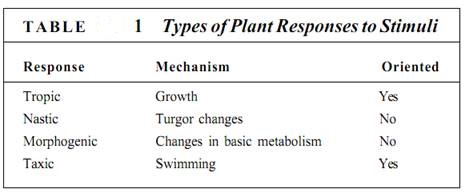
TROPIC RESPONSES
A tropic response, also called a tropistic response, is a growth response oriented with i regard to the stimulus. For example, when a plant grows toward a bright light, it is showing aphototropic response because the growth response is not random but oriented toward the light (Table 2). A positive tropism is growth toward the stimulus, a negative one is growth away from the stimulus, and a diatropic tropism is growth at an angle. Most lap roots are positively gravitropic, growing downward in response to gravity, whereas shoos are negatively gravitropic, growing upward in response to gravity. Branches and secondary roots grow horizontally or at an angle, diagravitropically. Experiments in which plants are temporarily grown in darkness have shown that the upward growth of shoots is negative gravitropism, not positive photo tropism.
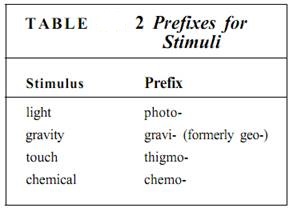
When touch is the stimulus, the response is thigmotropism. Positive thigmotroptsm occur when a tendril touches an object and, by growing toward it, wraps around it. We are net yet certain if touch is the true stimulus in all cases, because an object that touches a part may also shade it, so growth toward touch may sometimes actually be a response to a lack of light. Contact also blocks air movement, so the contact side may be more humid because the transpired water vapor is trapped; thus the true stimulus may be increased humidity. At least in pea plants, touch is known to be a stimulus: After a brief rubbing, tendrils coil toward the stimulated side, even if a physical object is no longer present to provide shade or trap humidity.
Pollen tubes of flowering plants display positive chemotropism, growing along the style to the ovary by following a gradient of chemical released from the ovule, probably from the synergids. Although the chemical responsible is not known for certain, the pollen tube is apparently sensitive to extremely slight variations in its concentration.
NASTIC RESPONSES
A nastic response is a stereotyped non-growth response that is not oriented with regard to the stimulus. For example, the trap-leaf of a Venus' flytrap has six large, sensitive trichomes. If a fly or other insect touches any two of these, the trap closes. It does not matter if the fly was moving north or south, up or down; the trap always closes in the same manner in this thigmonastic response. Furthermore, the trap does not grow shut; it closes as motor cells on the midrib upper side suddenly lose turgor.
Many pollinators are active only at night or during the day, and the flowers they pollinate are open only at the appropriate time. Sepals and petals spread open when the sun rises in diurnal species (active during daylight) and as it sets in nocturnal ones (active at night). Although presence of the pollinator is the critical factor for pollination, the cue that stimulates flower opening is the presence or absence of light, not the presence or absence of pollinators. The opening and closing always happen in the same manner, even if light is given artificially from the west, north, or south. This response is photonastic.
MORPHOGENIC RESPONSES
A morphogenic response, sometimes called a morphogenetic response, causes a change in the "quality" of the plant; that is, a fundamental change occurs in the metabolism of a tissue or even the whole plant. Photo-morphogenic responses are numerous: the induction to form flowers (which later open photonastically; Fig. 1), the induction of dormant seeds to germinate (Fig. 2), the induction of buds to become dormant. Many more occur because day length is such an excellent indicator of season. An example of a gavi-morphogenic response is the formation of fibrous wood when a stem or branch is tilted and becomes stressed by gravity (Fig. 3). Thigmo-morphogenic responses include formation of extra bark where branches rub against an object, and formation of a suture when petal or carpel primordia grow against each other .
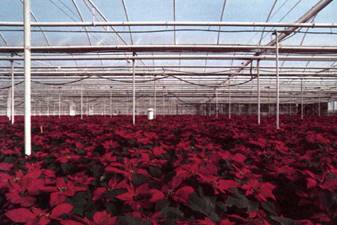
FIGURE 1: Conversion from the vegetative to the floral condition is a common photomorphogenic Day length is controlled in these commercial greenhouses to ensure that all the poinsettias bloom simultaneously at Christmas. The growers could just as easily make them bloom on the 4th of July by controlling day and night length. (Matt Meadows/Peter Arnold)
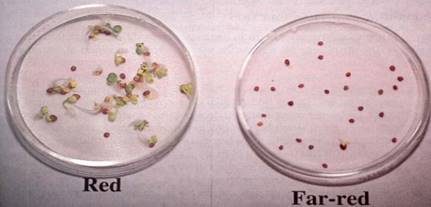
FIGURE 2: In these seeds and many others, a two-part mechanism ends dormancy: Cold winter temperatures and rain destroy or wash out an inhibitory chemical, and then light triggers germination. The light-dependent mechanism ensures that the seeds do not germinate while deeply buried under leaf litter and soil. Red light induces germination, but far-red light (infrared) blocks germination.
TAXIS
Taxis is a response in which a cell swims toward (positive taxis) or away from (negative taxis) a stimulus. Even in plants like mosses, ferns, cycads, and maidenhair tree (Ginkgo), spam cells swim to the egg cell by following a chemical gradient (chemotaxis). In algae, chemotaxis is similarly important for reproduction, and in many species, phototaxis allows them to swim toward light for photosynthesis or away from light that is too intense.
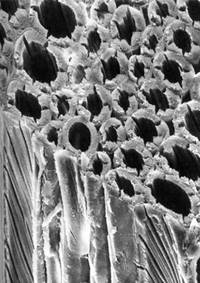
FIGURE 3 :"Reaction wood" in a branch of Douglas fir (Pseudotsuga). In a vertical trunk, the orientation of normal wood cells is ideal for resisting gravitational attraction (weight), but normal wood cannot hold up large horizontal branches. A gravimorphogenic response is the formation of reaction wood. In dicot trees, reaction wood is known as tension wood and is rich in gelatinous fibers whose walls are almost exclusively cellulose with little lignin or hemicellulose (X 640). (Courtesy of W. A. Cote, N. C. Brown Center for Ultrastnucture Studies, SUNY College of Environmental Science and Forestry, Syracuse, NY)
 الاكثر قراءة في مواضيع عامة في علم النبات
الاكثر قراءة في مواضيع عامة في علم النبات
 اخر الاخبار
اخر الاخبار
اخبار العتبة العباسية المقدسة

الآخبار الصحية















 قسم الشؤون الفكرية يصدر كتاباً يوثق تاريخ السدانة في العتبة العباسية المقدسة
قسم الشؤون الفكرية يصدر كتاباً يوثق تاريخ السدانة في العتبة العباسية المقدسة "المهمة".. إصدار قصصي يوثّق القصص الفائزة في مسابقة فتوى الدفاع المقدسة للقصة القصيرة
"المهمة".. إصدار قصصي يوثّق القصص الفائزة في مسابقة فتوى الدفاع المقدسة للقصة القصيرة (نوافذ).. إصدار أدبي يوثق القصص الفائزة في مسابقة الإمام العسكري (عليه السلام)
(نوافذ).. إصدار أدبي يوثق القصص الفائزة في مسابقة الإمام العسكري (عليه السلام)


















